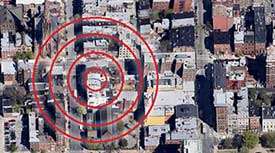Citizens’ concerns that methadone treatment centers (MTCs) might be focal points for serious crime are unwarranted, a recent NIDA-supported study suggests. Dr. Susan Boyd and colleagues at the University of Maryland School of Medicine in Baltimore found that crime rates in the immediate vicinities of that city’s MTCs were level with the rates in the surrounding neighborhoods.

The researchers used Baltimore City Police Department records from 1999‒2001 and global positioning data to plot the distribution of FBI Part I crimes (homicide, forcible rape, robbery, aggravated assault, burglary, larceny theft, motor vehicle theft, and arson) within a 100-meter (328-foot) radius of 15 MTCs. A statistical analysis of the plots showed that the crimes were no more frequent within 25 meters of the MTCs than they were 75 to 100 meters away.
In contrast to the case with MTCs, the likelihood of Part I crimes rose with closer proximity to convenience stores. The researchers suggest that the high volume of foot traffic around these stores provides opportunities for criminals to find victims. Consistent with this surmise, the frequency of crime declined near mid-block residences, where foot traffic is relatively sparse.
The study MTCs included all but one of the 16 centers located in Baltimore. They were situated in diverse communities, including inner-city, working-class, and middle-class neighborhoods, according to Dr. Boyd. The convenience stores and residences were located in neighborhoods that closely resembled those of the MTCs in demographic and social features that influence crime rates.
“There’s no evidence from our study of increased reports of crime around the methadone clinics,” says Dr. Boyd. She and colleagues are now analyzing data on actual arrests around the study sites to see whether drug sales and possession increase with proximity to methadone treatment centers. The researchers hope that demonstrating that MTCs are not hot spots for crime will reduce public resistance to the building of new centers, and thus remove an impediment to making methadone treatment more widely available.
 Crime Rates Around 15 Methadone Treatment Facilities, and Matched Convenience Stores and Residential Neighborhoods in Baltimore, 1999–2001 The annual rate of FBI Part I crimes* per unit area (1692 m2) was not significantly associated with proximity to methadone clinics. In contrast, crime increased with proximity to convenience stores and decreased with proximity to points within residential neighborhoods. *Homicide, forcible rape, robbery, aggravated assault, burglary, larceny theft, motor vehicle theft, and arson.
Crime Rates Around 15 Methadone Treatment Facilities, and Matched Convenience Stores and Residential Neighborhoods in Baltimore, 1999–2001 The annual rate of FBI Part I crimes* per unit area (1692 m2) was not significantly associated with proximity to methadone clinics. In contrast, crime increased with proximity to convenience stores and decreased with proximity to points within residential neighborhoods. *Homicide, forcible rape, robbery, aggravated assault, burglary, larceny theft, motor vehicle theft, and arson.
- Text description
-
Crimes measured for this study were all FBI Part I crimes, including homicide, forcible rape, robbery, aggravated assault, burglary, larceny theft, motor vehicle theft, and arson.
The figure shows that during both day (7 am to 7 pm) and night (7 pm to 7 am), the rate of crime at distances of 25, 50, 75 and 100 meters from methadone clinics is similar at each of the distances, generating a roughly horizontal line. The rates range from 1.2 to 1.8 during the day, and from 0.7 to 1.3 at night.
The plot for convenience stores shows the highest crime rates at 25 meters with rates of 2.9 during the day, and 3.4 at night, with declines to a level plateau of 0.7 to 1 at distances of 50, 75 and 100 meters.
Crime rates for hospitals and residential areas linearly increased with distance during the day, from 0.7 to 1.0 at 25 meters up to about twice that rate at 100 meters. At night, rates for residential areas also increased with distance, from 0.7 to 2.0, while at night crime rates were similar at all distances from hospitals, in the range of 0.4 to 1.2.
Source: Boyd, S.J., et al. Use of a “microecological technique” to study crime incidents around methadone maintenance treatment centers. Addiction 107(9):1632–1638, 2012. Abstract Available